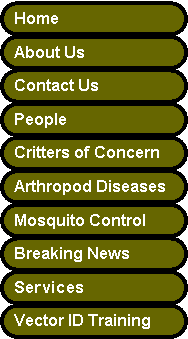


|
CDC miniature light trap: one of the most commonly used methods for vector surveillance. Click image for a preview on how it and other traps work! |
|
About Us |
|
What is Public Health Entomology? Public Health Entomology is the study of insects and related arthropods (spiders, scorpions, ticks, etc.) that pose human health threats to the public at large. These threats are primarily in the form of diseases, such as West Nile Virus, transmitted to humans by insects (e.g. mosquitoes), poisonous or noxious bites, and allergies or other indirect health problems.
What Does the Public Health Entomology Lab Do? We primarily conduct research into new and improved ways of controlling the insects of concern to public health officials. This research includes improving controls using chemicals, biological agents, and physical means. We also investigate how to better monitor the most troublesome insect populations and predict when and where disease threats will occur in the state. Currently, most of our research involves mosquitoes and sand flies, and the diseases they vector. This research is conducted by graduate students and professional staff of the laboratory in collaboration with numerous public health agencies and private corporations.
Current and Recent Projects: · A relatively new angle of the laboratory's research is studying sand flies. In various parts of the world, sand flies are vectors for a number of diseases, most notably, the parasite causing Leishmaniasis. Historically, sand flies were never reported from Kentucky. However, beginning in 2005, detection of these insects along the Tennessee border captured the interest of the laboratory. Currently, the lab is researching the whereabouts, natural history, and possible disease risks posed by these insects. Research into the mystery of their appearance in the region is also being studied. Much of this work is being conducted in cooperation with the US Military at the Fort Campbell, Kentucky Army Base. · We have just completed a 3-year project in Arequipa, Peru. This project sought to demonstrate the feasibility of a modern municipal mosquito control program in that city of 2 million people. · A small project of the lab’s is looking into the possibility of using Copepods (small aquatic organisms) as a predator to control mosquito larvae in the area. · An ongoing project through the lab’s existence is a survey of the mosquitoes of Kentucky. How many species do we actually have, and where are they? · Another continuing project, funded by a major international corporation, supports research into novel and unusual approaches to mosquito control– methods that will eventually lead to new and marketable products. · One study, completed in 2005, evaluated the effectiveness of commercial, residential mosquito control services for use in people’s backyards in Lexington suburbs. · Another study, completed in 2007, developed and implemented a non-chemical mosquito management program for use in extremely sensitive environments– a nuclear submarine base in South Carolina. |

